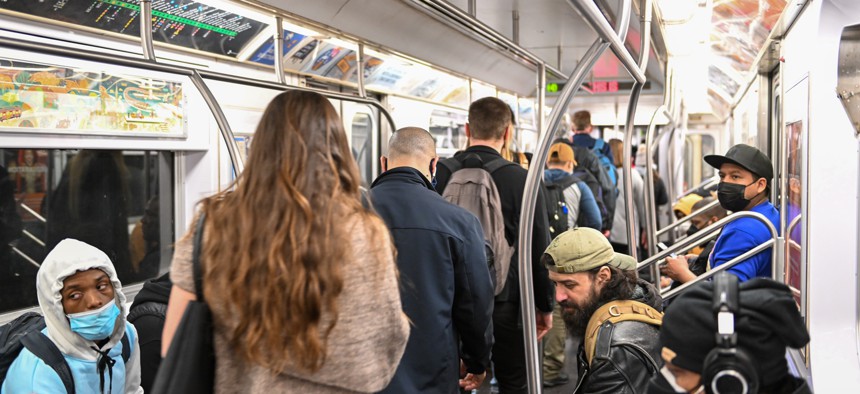Policy
State comptroller says MTA should be able to manage debt with state funding
A new report by Thomas DiNapoli found the financially-strained agency should be able to get on track with state funding and a higher payroll mobility tax in the budget.

While the MTA has been facing a real financial threat for years, the annual transit report by state Comptroller Tom DiNapoli released today found the strained agency should use funding in the state budget to get back on its feet. Alexi J. Rosenfeld/Getty Images
While the Metropolitan Transportation Authority has been facing a real financial threat for years, the annual transit report by state Comptroller Tom DiNapoli released on Friday found the strained agency should use funding in the state budget to get back on its feet.
“The MTA received the state funding it requested to address its latest fiscal crisis,” DiNapoli said in a press release. “It should use this opportunity to stop its recurring cycle of fiscal crises by paying down and managing its debt more appropriately to shore up future operating and capital budgets.”
The final state budget included $300 million in one-time aid for the agency and $35 million to improve subway service frequency. More funding for the agency will come from a $165 million annual investment to the agency from New York City and increased payroll taxes from city businesses to help the financially strained agency. The state comptroller and the governor have both said the payroll mobility tax will provide the agency with $1.1 billion.
The annual report asserts that the agency should use state funding to support operating expenses and manage debt. “Based on the receipt of this new support and using federal COVID-19 aid, the MTA has prepaid $1.4 billion in principal and interest, freeing up $1.5 billion for other operating purposes in 2023 through 2026,” the report reads.
According to the report, the agency’s long-term debt is expected to reach $56.7 billion by 2028. But, the office estimates the debt burden on the agency will be 16% from 2023-2026, calling it a “significant reduction” from current forecasts.
MTA spokesperson Michael Cortez said the agency is committed to operating efficiencies to ensure reliable, safe and frequent service in a statement to City & State. “Comptroller DiNapoli sounded an early alarm about the MTA’s fiscal cliff, and Governor Hochul and State legislators have stepped up for New Yorkers and provided recurring stable funding for mass transit,” Cortez said.
For years, the MTA has been plagued with financial issues. Those problems were only exasperated by the coronavirus pandemic which caused ridership to decrease significantly. The federal government has awarded the MTA $15 billion in COVID-19 relief funds since 2020. The agency’s CEO Janno Lieber has warned of the system’s financial problems and called for funding solutions other than increasing fares. The agency has struggled to get ridership back to pre-pandemic levels since and celebrated a milestone of 4 million paid riders for the first time since 2020 just a few weeks ago.
Danny Pearlstein, policy and communications director for the public transit organization Riders Alliance, has pushed for the agency to achieve more frequent service – with the popular #6MinuteService campaign. In a text, Pearlstein said lawmakers and public officials are taking responsibility for basic infrastructure and setting a national standard for transit investment. “With $35 million for additional off-peak service on a dozen subway lines, the MTA will be running more trains than New York has seen in several decades,” Pearlstein wrote.
Along with frequent service, transit advocates as well as New York City lawmakers were pushing for a “Fix the MTA” package. If implemented, the package would have frozen subway fares at $2.75, made all buses free, improved service and would be paid for through increased taxes on wealthy New Yorkers. In the end, supporters of the plan celebrated the final state budget inclusion of the free fares pilot program and funding for service improvements.
In a statement to City & State, Assembly Member Zohran Mamdani, a champion for the “Fix the MTA package” said he had conversations with the Comptroller’s office about the MTA’s debt practices and the agency’s need to MTA to reduce its debt service or borrowing costs when crafting the bill. “Today’s report from the Comptroller supports language that we put forward in our spending bill requiring the issuance of bonds with level debt service requirements. I’m eager to see the MTA engage with these recommendations on the use and structuring of debt going forward,” Mamdani wrote. The Assembly member added the fight for “excellent, accountable, and universally accessible” transit service is still ongoing.
Along with the MTA spokesperson and Pearlstein, the comptroller's report underscored the sentiment that the agency needs to ultimately focus on increasing ridership to help with its financial crisis. “Success in bringing riders back to the system, and thereby boosting revenue, would help alleviate the debt burden over the long-term,” the report reads.
While the office sees a path forward for the financially strained agency with state funding, DiNapoli did caution the agency in dealing with its finances moving forward, given the low ridership numbers. “How (the MTA) decides to bridge the gaps after 2026 and manage its debt can determine whether it remains on firm financial ground or whether it comes back to riders, toll payers and taxpayers for more assistance down the road,” DiNapoli said in a statement.

